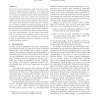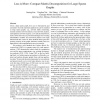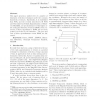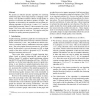97
Voted
SDM
2007
SIAM
15 years 2 months ago
2007
SIAM
The recent years have witnessed a surge of interest in graphbased semi-supervised learning methods. The common denominator of these methods is that the data are represented by the...
120
click to vote
SDM
2007
SIAM
15 years 2 months ago
2007
SIAM
Many clustering algorithms have been proposed to partition a set of static data points into groups. In this paper, we consider an evolutionary clustering problem where the input d...
80
Voted
SDM
2007
SIAM
15 years 2 months ago
2007
SIAM
SDM
2007
SIAM
15 years 2 months ago
2007
SIAM
The problem of identifying mislabeled training examples has been examined in several studies, with a variety of approaches developed for editing the training data to obtain better...
116
Voted
SDM
2007
SIAM
15 years 2 months ago
2007
SIAM
Given a large sparse graph, how can we find patterns and anomalies? Several important applications can be modeled as large sparse graphs, e.g., network traffic monitoring, resea...
105
Voted
SDM
2007
SIAM
15 years 2 months ago
2007
SIAM
This paper presents a unified view of a number of dimension reduction techniques under the common framework of tensors. Specifically, it is established that PCA, and the recentl...
102
Voted
SDM
2007
SIAM
15 years 2 months ago
2007
SIAM
The problem of combining the ranked preferences of many experts is an old and surprisingly deep problem that has gained renewed importance in many machine learning, data mining, a...
99
Voted
SDM
2007
SIAM
15 years 2 months ago
2007
SIAM
We present an efficient dynamic algorithm for clustering undirected graphs, whose edge property is changing continuously. The algorithm maintains clusters of high quality in pres...
128
Voted
SDM
2007
SIAM
15 years 2 months ago
2007
SIAM
Local pattern mining algorithms generate sets of patterns, which are typically not directly useful and have to be further processed before actual application or interpretation. Ra...
149
click to vote
SDM
2007
SIAM
15 years 2 months ago
2007
SIAM
Nonlinear dimensionality reduction methods often rely on the nearest-neighbors graph to extract low-dimensional embeddings that reliably capture the underlying structure of high-d...




